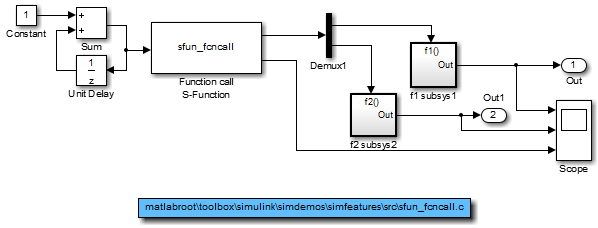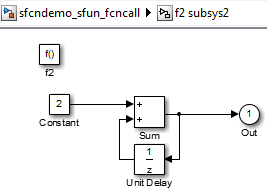Implement Function-Call Subsystems with S-Functions
You can create a triggered subsystem whose execution is determined by logic internal to a C MEX S-function instead of by the value of a signal. A subsystem so configured is called a function-call subsystem. To implement a function-call subsystem:
In the Trigger block, select function-call as the Trigger type parameter.
In the S-function, use the
ssEnableSystemWithTidssDisableSystemWithTidssCallSystemWithTidIn the model, connect the S-Function block output directly to the trigger port.
Note
Function-call connections can only be performed on the first output port.
Function-call subsystems are not executed directly by the Simulink® engine; rather, the S-function determines when to execute the subsystem. When the subsystem completes execution, control returns to the S-function. This figure illustrates the interaction between a function-call subsystem and an S-function.

In this figure, ssCallSystemWithTid executes the function-call
subsystem that is connected to the first output port element.
ssCallSystemWithTid returns 0 if an error occurs while executing
the function-call subsystem or if the output is unconnected. After the function-call
subsystem executes, control is returned to your S-function.
Function-call subsystems can only be connected to S-functions that have been properly configured to accept them.
To configure an S-function to call a function-call subsystem:
In
mdlInitializeSizes, set the data type of the S-function first output port to function-call by specifyingssSetOutputPortDataType(S, 0, SS_FCN_CALL);
Specify the elements that are to execute the function-call subsystem in
mdlInitializeSampleTimes. For example:ssSetCallSystemOutput(S,0); /* call on first element */ ssSetCallSystemOutput(S,1); /* call on second element */
Specify in
mdlInitializeSampleTimeswhether you want the S-function to be able to enable or disable the function-call subsystem. Only S-functions that explicitly enable and disable the function-call subsystem can reset the states and outputs of the subsystem, as determined by the function-call subsystem's Trigger and Outport blocks. For example, the codessSetExplicitFCSSCtrl(S, 1);
in
mdlInitializeSampleTimesspecifies that the S-function can enable and disable the function-call subsystem. In this case, the S-function must invokessEnableSystemWithTidbefore executing the subsystem usingssCallSystemWithTid.Execute the subsystem in the appropriate
mdlOutputsormdlUpdateS-function routine. For example:static void mdlOutputs(...) { if (((int)*uPtrs[0]) % 2 == 1) { if (!ssCallSystemWithTid(S,0,tid)) { /* Error occurred, which will be reported by */ /*the Simulink engine*/ return; } } else { if (!ssCallSystemWithTid(S,1,tid)) { /* Error occurred, which will be reported by */ /*the Simulink engine*/ return; } } ... }
See sfun_fcncall.c for an example that executes a function-call
subsystem on the first and second elements of the first S-function output. The following
Simulink model (sfcndemo_sfun_fcncall) uses this S-function.

The first function-call subsystem provides a sine wave output. The second function-call subsystem is a simple feedback loop containing a Unit Delay block.


When the Pulse Generator emits its upper value, the function-call subsystem connected to the first element of the first S-function output port is triggered. Similarly, when the Pulse Generator emits its lower value, the function-call subsystem connected to the second element is triggered. The simulation output is shown on the following Scope.

Function-call subsystems are a powerful modeling construct. You can configure Stateflow® blocks to execute function-call subsystems, thereby extending the capabilities of the blocks. For more information, see the Stateflow documentation.
See Also
ssEnableSystemWithTid | ssDisableSystemWithTid | ssCallSystemWithTid